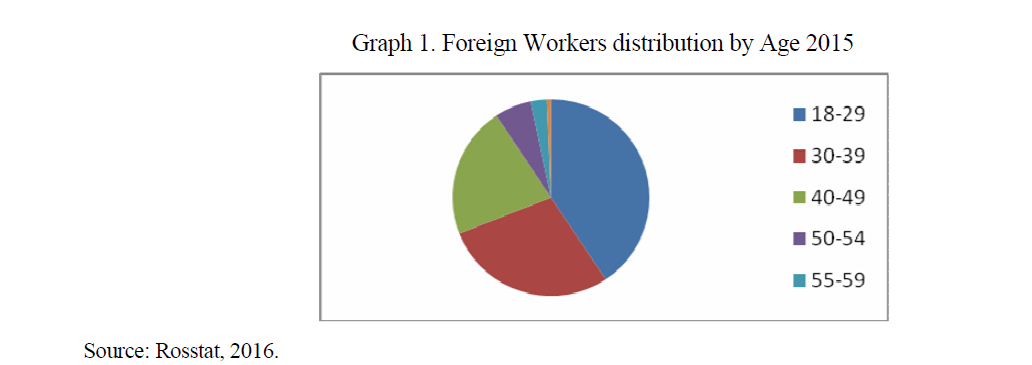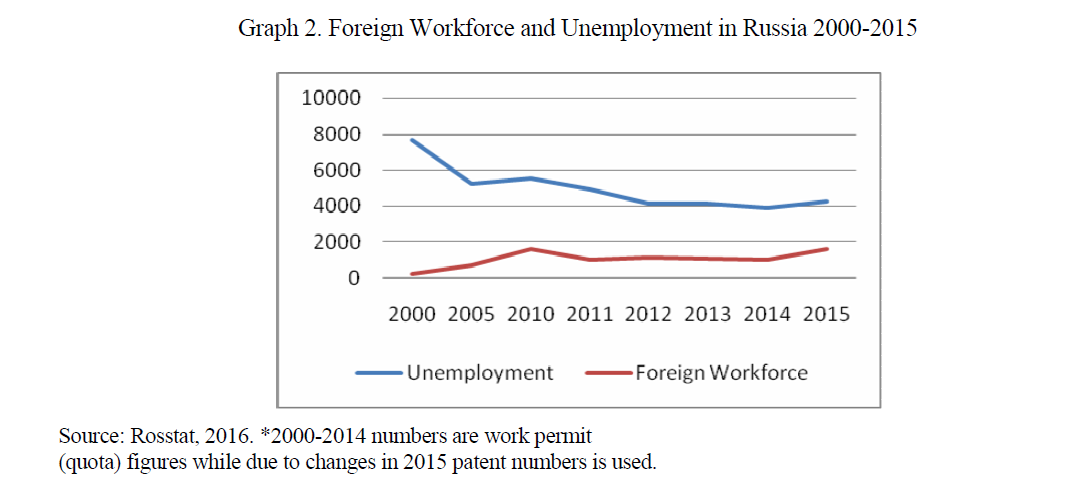Abstract
During the 1995-2015 years number of population in Russia has fallen around 4.8 million. In relation with this decrease the number of the working-age population reduce by 3.6 million between 2011-2015 and according to forecasts it will continue to fall in the next 15 years. One of the major reason for the expected fall is the low fertility rate between 1995-2005 years. In other words number of workers who will join the workforce between 2015-2020 is lower than the number of workers who will retire from the workforce. On this point the most viable option is migration based option where Russia needs to attract foreign workers other than Central Asian ones in order to cover the losses that will occur in the near future.
Russian Federal State Statistics Service has prepared a forecast on demographic situation in Russia that analyzed population dynamics under three scenarios in 2010. the major concern regarding the Russian labor market’s future is even in the ideal version of the forecast; working-age population will decline 4.1 million workers whereas this figure is for medium variant 6.8 million and for low variant almost 10 million by 2030. [1].As medium version stated that, the population of working-age between 2011-2017 years will decrease by 1 million people annually [1].
According to this forecast, the population of working-age supposed to decrease 5 million until the end of 2015. However in reality during 2011-2015 years the working-age population decreased by 3.6 million people. Among the sectors, greatest decrease occurred in the real sector of the economy mainly in industry and agriculture. [2]. At the same time, the number of foreign workers increased from 1 million in 2011 to 1.6 million in 2015 [3]. During the 2011-2015 years, Russian government manages to increase the number of foreign workforces only by 600 thousand while lost 3.6 million people from its labor force. A closer look at the solution of the labor market allows us to analyze how to fit the arriving migrant workers to address issues of the Russian labor market.
Regional distribution of foreign workers is calculated according to the number of patent holders between 2013- 2015 years. Foreign workers are heavily concentrated in Central federal district and Northwestern district in 2015. As for other regions, their share is ranged between 1-15% where most of them are below 10%. In terms of receiving migrant workers, the Northwestern region has significantly increased its share from 2.4% in 2013 to 16.9% in 2015 while all the other regions share are reduced during this period. [3].
Big cities like Moscow and St. Petersburg attracts a large number of foreign workers with their high salaries and demand for labors. The arrivals to Moscow city consisted 16.8% of total number of foreign workers in 2013 later on in 2014 this figure jump to 33.1% meaning every 1 out of 3 foreign worker choose to migrate to Moscow and finally as for 2015 the number fall to 26.4% but still higher than any other district. [3]. An important note here is that Moscow is included within the Central region and only shown in the graph to illustrate its significant share in the regional distribution.
Although patent price in Central and Northwestern districts are one of the most expensive (Moscow city 4000 rubles, St. Petersburg 3000 ruble monthly payment) regions still 63.9% of patent holders reside in these two districts in 2015. This could be associated with the higher salaries and constant demand for cheap labor. The average salary in Moscow is 59567 ruble (around 993 US $) which is twice higher than the country average 30225 ruble (around 504US $). This number for St. Petersburg is around 39845 ruble (around 664 US $) which is times higher than the country level. [4]. However, migrant workers receive relatively less than local In order to assess the wage difference between local and labor migrants, Denisenko and Varshavskaya state that comparing the hourly payment would be more appropriate than the total sum of the salaries. In their survey result, they find out that difference between salaries varies according to the sector where labor migrants receive 10% less than local workers in trade, while this figure is 19% for construction and by average 12% for transport and communication sectors. [5].
Among foreign workers, a large part of them is from Central Asian countries where Uzbekistan and Tajikistan take the lead. For instance, Uzbek labor migrants hold the leadership for more than 5 years in a row and in 2015, Uzbek labor migrants alone accounted for 52% of the total number of patents purchases while Tajik labor migrants are a distant follower and positioned in second place with 25%. [6]. The rise of the Central Asian migrant workers started after 2007 with the simplification of the obtaining a work permit procedure their share rise from 16.9% in 2005 to 78% in 2015. [6]. Alongside with Central Asian countries, a significant amount of Ukrainian labor migrants is also arriving in Russia looking for better job opportunities. Their number substantially increased from 36,300 in 2013 to 252,600 in 2014 and slightly decreased in 2015 to 202,700 this fall could be linked to the conflict between Russia and Ukraine. [6].
It is promising to see that among labor migrants the largest share belongs to youth 18-29 age group and the share of 18-49 age group is 91% of which 41% is young migrant workers. Considering the average working age in Russia this is good news because nearly half of the migrant workers are under 30 [6].

Graph 1. Foreign Workers distribution by Age 2015
Source: Rosstat, 2016.
However, in order to have a significant influence over the labor market, their numbers need to be higher. Currently the share of legal migrant workers consist only 3% and in combination with illegal ones around 8% of the total workforce in Russia [6].

Graph 2. Foreign Workforce and Unemployment in Russia 2000-2015
Source: Rosstat, 2016. *2000-2014 numbers are work permit (quota) figures while due to changes in 2015 patent numbers is used.
Inviting more foreign workers will not increase unemployment significantly. Therefore, the common stereotype that foreign workers steal jobs of the local people assumptions is not fully true. It could be seen that the changes in the number of unemployment and number of foreign workers are regulated by the economic structure in the country. Both figures are positively affected by the economic growth in Russian economy throughout the 2000-2008 years where unemployment fall from 7.7 million to 5.24 million at the same time number of foreign workers increased from 213 thousand to 1.65 million. Indicating that unemployment and hiring foreign workforce is not inversely correlated. [6]. In additions to that, in the case of economic crisis labor migrants are first to be fired therefore they also function as a barrier in the labor market. [7].
In Russian labor market, the share of unskilled and average skilled workers consist 70% of the total arrivals while the share of rest of the skilled professionals is 30% and among them, the share of the high skilled professionals is only 3%. The majority of the foreign workforce in Russia is ordinary workers who often accept dirty, dangerous and demeaning jobs that are also known as (3D jobs). [6]. On this point, higher wages is the major motivator allowing them to bare the difficult conditions. Occupational skills distribution represents that the structure of migration flow is rather receiving cheap labor force than a brain drain situation. [8].
According to the labor and employment statistics of Rosstat in 2014 entrepreneurs hired 939,3 thousand foreign workers. The biggest demand for hiring a foreign worker appears in wholesale, repair and household goods sectors with 352.6 thousand (38%) while construction sector took the second place with 163.3 thousand (17%) in 2014. Alongside with these two major sectors, there is balanced distribution among other sectors where 60-90.000 workers or 6-9% of them are worked in manufacturing, real estate, agriculture, transport and communication, hotels and restaurant business. On the other hand, foreign workers assistance is least required in education, healthcare, and social services sectors. Combining the skills ratio with sectors it could be said that entrepreneurs are hired them for mostly labor-intensive jobs like repair, construct, sell and produce which may or may not require high skills to fulfill their jobs. [6].
Labor migrants’ profile shows that a large part of them is young, average skilled workers who are currently fulfilling the undesired jobs and working for less wages than locals. The fewer wage and accepting difficult conditions makes them desirable in the eyes of the employers and has become their comparative advantages against local unskilled workers. Within the current structure manufacturing and agriculture sectors requires the most assistance whereas the majority of the labor migrants work at wholesale repair and household goods and construction sectors and only 8% of them works in agriculture sector while this figure is 7% for manufacturing. In terms of the aging issue, they promise a great opportunity but their share is too small to have a significant impact on the average working age.
In conclusion, looking at the profile of the current migration flow we see that they have a potential to reverse the aging of the workforce problem but due to their small share in the workforce currently their effect is minimal. In addition to that, migrant workers contribution to losses in the labor market is also not significant due to their sectoral distribution where biggest labor losses occur in the agriculture and manufacturing sectors while most of the labor migrants are concentrated on wholesale, repair and household goods and in construction sectors. Bottom line Russian labor market has a facing serious long-term problem which requires both short-term and long-term initiatives to solve its problems. Migrants could play a significant role in the solution process of these problems if their flows are increased and managed in accordance with the needs of the Russian labor market.
Reference:
- Estimated number of population of the Russian Federation // http://www.gks.ru/wps/wcm/connect/rosstat_main/rosstat/ru/statistics/publications/catalog/doc_1140095525812
- Working-age Population is in Decline // http://ac.gov.ru/en/events/010771.html
- Regions of Russia // http://www.gks.ru/wps/wcm/connect/rosstat_main/rosstat/ru /statistics/publications/catalog/doc_ 1138623506156
- Russia in Figures 2016 // http://www.gks.ru/free_doc/doc_2016/rusfig/rus16e.pdf
- Migrants at the Russian Labour Market: Characteristics, Status, Mobility // http://www.ub.edu/searchproject/wp- content/uploads/2013/07/WP_3_21.pdf
- Labour, Employment and Unemployment in Russia //http://www.gks.ru/free_doc/doc_2016/rab_sila16.pdf
- Role of International Labour Migration in Russian Economic Development //http://cadmus.eui.eu/handle/1814/23479
- Russia's Current Economic Conundrum //http://www.sras.org/russia_economic_crisis_2015